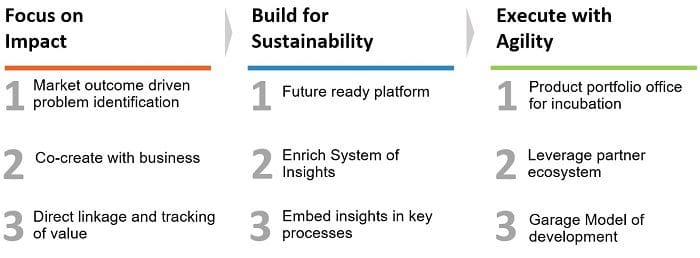Why organizations fail in scaling AI and Machine Learning
We explain why AI needs to understand business processes and how the business processes need to be able to change to bring insight from AI into the process.
In today’s world, every organization is working on Artificial Intelligence (AI) driven transformation in some shape or form. The hype created by AI is very strong and organizations have atleast some hype (not high) profile team working on AI. However, the charm of AI fades within a short while, when organization/s realize that they have not been able to get the extremes of high-end AI and seemingly mundane business process meet, to deliver the bottom/top line metrics. The challenge is not in AI or business process individually, AI needs to understand business processes and the business processes need to be able to change to bring insight from AI into the process.
It is great for an AI project to start with a grand strategic vision that gets the team started. The important part here is to ensure that the team include members that have strong operational view and can translate the strategy to implementation in the organization.
Let’s take a simple example of Churn reduction in Telecom and look at challenges in making it sustainable:
Existing Scenario: The post-paid customers cancel the connection voluntarily, by calling the operator and requesting the closure of their account. Let’s say 100 customers request cancellation monthly. The operator responds by providing a $50 discount for future bills and retains 50% the cancellation requests. Retention team works on a budget of 100*50%*50 = $2500 to retain customer. The P&L team gets a revenue of ARPU $60 for 50 customers for a year. Revenue retained = $60*50*12 = $36000. In achieving this the contact centre team made 2 calls per prospective churner, 2*100 = 200 calls.
AI Scenario: The vision suggests identifying prospective churners in advance and retaining them by taking a proactive action. The Data scientist team identifies 120 customers likely to churn with 70% confidence (i.e 84 customer would have anyway requested for cancellation in future). The operator responds with the $50 discount. The acceptance rate of the discount increases as the list includes people who would not have requested a churn. Thereby the retention budget goes up i.e 120*60%*50 = $3600. The revenue retained = $60*60*12 = $43200. Calls made to achieve the objective, 2* 120 = 240.
Now, if we observe the overall expected achievement, AI scenario is a clear winner with higher retained revenue ($43200 Vs $36000).
However, lets look at the softer aspects that are overlooked:
- The two supporting business processes, retention dept and the contact centre have to increase their capacity and budget. Also, the increase in cost comes before the improvement in revenue. This leads to a conflict of interest within the sub-organizations and the supporting departments don’t work in alignment for the overall business objective.
- The contact centre has to add outbound capability for retention. This is a bigger challenge, as setting up a new process to include AI insights is huge change management process for the organization. The AI team would not have thought of requiring a new process to complete the execution.
- The success of the AI project is rarely about the algorithm, where people tend to spend most of their time. Getting the team aligned requires ability of the Data scientist to explain the results. Current day data scientist wok on the black box algorithm that provide higher accuracy, but the results are challenged in explanatory power of AI. The link to causality is an important requirement of getting team alignment. People will not act unless they understand in simple language they relate.
- The skills required to do a proof of concept and infusing AI process in business are very different. The POC requires a strong story teller and bringing the simplicity in the business problem. The implementation will require process changes across various stakeholders, connecting the various IT systems, the source data challenges, data completeness, process /data governance and policies adhered etc..
To plan AI transformation, the following framework highlights the key requirements of success for an AI transformation program.

This framework focuses on the importance of the co-creation with the stakeholders such that from the very beginning the value of the program is understood in a common language, challenges of implementation identified - discussed - understood, skills aligned across the various phases of the project, and project delivered with agility.
However, the nature of AI makes it important to understand that not all the initiatives will be successful as the data/ insights might not be good enough. Executing with agility and sustainably also requires an understanding of ‘failing fast’. The objective is to succeed in driving AI as an organization initiative, even if it requires some projects to be shelved after quick evaluation.
Hence, a garage model that is built like Lego blocks for various initiatives, skill ecosystem, agile development and market testing is required.
Overall, strong organization change management process needs to be built to infuse AI for business transformation, without which there will be successful trials with very limited impact.
And as the wise few say “Keep It Simple Stupid”.
Bio: Prateek Mital is an Associate Partner with IBM for the Cognitive and Analytics Service line in Asia Pacific. Views are his personal based on extensive customer engagements with worldwide clients.
Resources:
- On-line and web-based: Analytics, Data Mining, Data Science, Machine Learning education
- Software for Analytics, Data Science, Data Mining, and Machine Learning
Related:
